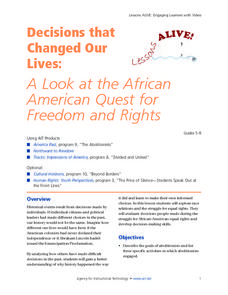Curated OER
Persuasion in Historical Context: The Gettysburg Address
The Gettysburg Address is a powerful text. Use it to teach persuasion and the importance of word choice. The activity detailed here includes a scaffolded background knowledge activity that includes image analysis of photos from the Civil...
K12 Reader
Underground Railroad: On to Freedom
The Underground Railroad is the focus of a coloring worksheet, which provides background information about the volunteers who aided escaping slaves.
City University of New York
The Split Over Suffrage
Compare and contrast Frederick Douglass's and the National Women's Suffrage Association's stances on equal rights and suffrage with a series of documents and worksheets. Learners work together or independently to complete the packet, and...
EngageNY
Grade 9 ELA Module 4, Unit 1, Lesson 17
How did the Demerara Rebellion of 1823, the death of Reverend John Smith, and the Emancipation Bill of 1833 that abolished slavery throughout the British Empire change the sugar industry? Class members examine how the authors of Sugar...
University of Virginia
Uncle Tom's Cabin: Finishing the Novel
The reviews for Harriet Beecher Stowe's Uncle Tom's Cabin were as divisive as the novel itself. High schoolers finish the novel unit with an evaluation of the book's initial reviews, its characters' dreams and fears of emancipation, and...
University of Virginia
Uncle Tom's Cabin: Reading the Novel
Teach the importance of context and perspective with a unit focused on Harriet Beecher Stowe's Uncle Tom's Cabin. The first lesson considers the role of female characters and readers, including the gender expectations of the time. The...
Education City
Black History Month
Enhance Black History Month with a twenty-page resource designed to boost scholars' knowledge of the great accomplishments made by African Americans. Learners take in fun facts about famous inventors such as George Washington Carver and...
Smithsonian Institution
John Brown’s Legacy
So who exactly was John Brown? John Brown fought for abolition during the Civil War. Scholars learn all about his legacy through the variety of activities in the sixth of 15 lessons, including viewing and analyzing primary source...
New York State Education Department
US History and Government Examination: June 2012
The reform movements—such as abolition, the push for women's suffrage, and the labor movement—shaped modern America. A document analysis activity and essay prompt help learners consider why. Other items in the high-level exam include an...
US House of Representatives
“The Fifteenth Amendment in Flesh and Blood,” The Symbolic Generation of Black Americans in Congress, 1870–1887
The reading of a contextual essay launches a study of Black Americans who served in Congress from 1870 through 1887. Young historians identify the African Americans who served during this period, investigate the ways they won national...
Digital Public Library of America
The Underground Railroad and the Fugitive Slave Act of 1850
Escaping Enslaved people attempting to escape didn't need a ticket to ride on the Underground Railroad. Here is a packet of primary sources that reveal the kind of courage and determination they did need to face the challenges to gain...
Center for History Education
Nineteenth Century Reform Movements: Women's Rights
It's hard to imagine a world where women were marginalized from the seats of power. Yet, there are women today who remember what it was like to not be allowed to vote. Using a DBQ of images and other primary sources, such as political...
ESRI
Juneteenth: An American History through Maps
An interactive website traces the history of Juneteenth celebrations from their origin in Galveston, Texas, on June 19th to the present day. Using interactive maps, learners can find information about the African-American population...
Center for History Education
Where Did Thomas Jefferson Stand on the Issue of Slavery?
Thomas Jefferson was a complicated man with a complex legacy. Middle schoolers examine a series of primary source documents to gather evidence for an essay in which they answer where Jefferson stood on the issue of slavery.
Livaudais-Baker English Classroom
Kindred Unit Project
To conclude a unit study of Octavia E. Butler's Kindred, groups use MovieMaker or the class website to publish an original story about slavery in America. The detailed project assignment sheet includes a list of possible topics,...
Curated OER
Perspective on the Slave Narrative
Students work with the slave narrative as a resource for historical study and evaluate it as a work of literature; students then examine the narrative in the context of political controversy as an argument for abolition.
Curated OER
Creating an Abolitionist Newspaper
Fourth graders develop an understanding of the lives of slaves and their quest for freedom. They develop an understanding of the people who fought against slavery and the efforts that were made by them to create a better life for all...
Curated OER
Decisions That Changed Our Lives: A Look At the African American Quest for Freedom and Rights
Students are introduced to the goals of abolitionists throughout history. In groups, they use the internet to discover the purpose of the Underground Railroad and why there were bus boycotts in the 1960s. They compare and contrast the...
Curated OER
White Southerners' Defense of Slaveholding
Students read transcriptions of articles from two historical Virginian newspapers and examine how white southerners defended the institution of slavery. They write a one-act play or a dialogue between an abolitionist and a slaveholder.
Curated OER
Reformers
Students research reform efforts during the 1800's, primarily those leading up to the Civil War. They complete several lessons that investigate the life of Sojourner Truth and her contributions to the abolitionist movement and women's...
Curated OER
John Brown Lesson Plan
Students create timelines of the Harper's Ferry Raid. In this Civil War lesson, students analyze information and music related to John Brown and his abolitionist work. Students design timelines that document the events that led to and...
Curated OER
Fredrick Douglass...A Digital History
Seventh graders research the life of Fredrick Douglass. In this Fredrick Douglass lesson, 7th graders read about his life and discuss it. They write poetry describing his experience as a slave and create their own monument for Fredrick...
Curated OER
This Guilty Land
Middle schoolers investigate the actions and motives of John Brown. In this abolition lesson, students discover details about Brown's background as a free-state and abolition supporter. Middle schoolers discuss his role as that of a...
Curated OER
Freedom Timeline
Students explore the issue of the morality of slavery in the 18th and 19th centuries in the United States and construct a timeline containing freedom facts. Freedon issues and the rights and responsibilities of the time are examined.
Other popular searches
- Abolitionists Powerpoint
- Role of Abolitionists
- Famous Abolitionists
- Worksheets Abolitionists
- Abolitionists Civil War
- Abolitionists in Indiana
- Abolitionists Susan B Anthony

























